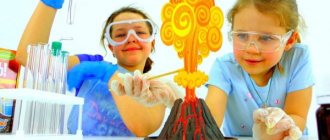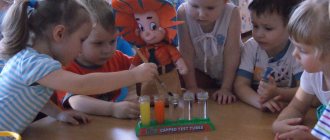Preparatory group. Senior preschool age. Children 6-7 years old
Abstract of the OOD on the development of cognitive and research activities “Miracle Salt” in the preparatory group Municipal budgetary preschool educational institution Kindergarten No. 33 “Rodnichok”
urban district of the city of Oktyabrsky of the Republic of Bashkortostan
Abstract of organized educational activities for the development of educational and research activities on the topic : “Miracle salt”
...
Summary of a lesson in a speech therapy group preparatory to school on research activities “Creating a greenhouse” Lesson in a speech therapy group preparatory to school on research activities “Creating a greenhouse”
.
Goal: Create conditions for research activities , teach how to make a greenhouse from waste material, care for plants in various conditions, educate...
MAGAZINE Preschooler.RF
Summary of research activities in the preparatory group using technology Savenkova A.I. Topic: "Stone"teacher of the first category Dolgiy Liliya Mikhailovna, MBDOU “Combined kindergarten “Golden Key”, Yamalo-Nenets Autonomous Okrug, Purovsky district, Tarko-Sale.
Goal: development of children's initial competence, research abilities and skills.
Tasks:
Educational:
- introduce children to the general scheme of research activities
- develop children's research abilities by teaching the use of various techniques for obtaining information in the course of their own research search for obtaining knowledge
- introduce children to a variety of stones in shape, size, color, strength; learn to identify and name the properties and features of stones.
Educational:
- teach research techniques through experiments and experimentation
- take part in a group conversation, reason, justify your statements, listen carefully to your interlocutors
- activate children's vocabulary; develop demonstrative speech, the ability to use complex common sentences
Educational:
- cultivate initiative, the desire to observe, experiment, independently seek new information about the world, apply your knowledge when solving problem situations
Speech:
- enrich, activate and update the vocabulary
- form the grammatical structure of speech.
Health savers:
- ensuring emotional well-being in the process of children's activities, timely change of children's static position
- strengthen the muscles of the respiratory system, nasopharynx and upper respiratory tract.
Activities:
Communicative, cognitive-research, gaming, motor.
Materials and equipment:
Interactive board, projector, laptop, set of stones, diagram cards describing the properties of stones. Materials for experimental research work: containers with water, magnifying glasses, various stones, nets, white coats, trays, plastic plates, encyclopedias, medals, scientists' robes.
Expected result:
- children develop the skills of initial competence, research abilities and skills
- children are able to draw up a general outline of research activities
- children's research abilities are activated
- use various methods of obtaining information during their own research search for knowledge acquisition
- children got acquainted with a variety of stones in shape, size, color, strength
- identify and name the properties and characteristics of stones.
Move
slide 1 (lab)
Children enter the group and are greeted by a teacher (in a robe).
Educator: Hello, guys! Welcome to our research laboratory. My name is Liliya Mikhailovna. Today we will do research. I will be the scientific supervisor, and you are my colleagues. To do this, we have to put on robes and turn into scientists who explore the world around us. Dear colleagues, I would like to remind you that in our laboratory there are rules that must be followed (don’t make noise, know how to negotiate with your comrades, know how to finish your work on time). And so, dear colleagues, please take a seat. With the help of a riddle we will determine the topic of our research. Listen carefully.
Mystery.
It burns with fire in my mother’s earrings. It lies useless in the dust by the road. It changes shape, it changes color, And in construction it is good for a thousand years.
It can be small - lie in the palm of your hand. It's heavy and big - you can't lift it alone.
(Stone)
What do you think we will explore today?
(on slide 2 there is a picture of a stone). Stone.
Our task is to find as much information as possible about the stones.
Let's think about what you know about stones? (put out the “think for yourself” )
Where else can you find information? During a collective discussion, children name the main methods.
Well done, you named a lot of sources.
And today we will look for information in four sources: “read in a book” , “observe” , “find out on the Internet” , “ask another person” .
I suggest you go to the table and take one card, with which you can find a partner for research and determine the place of work.
The first pair with a card is a computer, they go to the computer, look for information about the stone and record the information received using schematic drawings.
The second pair with the scientist’s card asks for information from other guests present at the event and records the information received using schematic drawings.
The third pair with a card - find it in a book, go to the table with encyclopedias and look for information in them.
The work time is limited, you need to finish the work within the time allocated by the hourglass.
Children work independently. The teacher comes to each table and helps the children.
After the time is up, the teacher offers the children another source of information: let’s conduct an experiment.
The children and the teacher come to the table.
What can be done with water and stone.
And now, guys, we will learn a few more properties of the stone and conduct interesting experiments: we will determine the temperature and buoyancy, and study the surface of the stones.
Educator: Take one stone in each hand and use your fingers to examine the surface. What can you say what she is like? (Children's answers) Smooth stones are sea stones, put them in your palms and try to mix them, just like in the sea, the stones rub against each other and smooth out the corners.
Now put one stone in the water, and squeeze the stone that remains in your palm, see which stone is in the water. Why? (children's answers)
Now, using a net, remove the stone from the water and place both stones on your cheeks, what is the difference between a wet and a dry stone? (Children's answers) Let's try to warm the stones.
How can we do this?
Breathing exercises: Children take all the stones, place them on their palms, inhale through their nose, and exhale through their mouth, lips using a tube. (3-4 times)
Which stone warmed up the most and why?
Conclusion: stones can be warm or cold. The temperature of the stone changes under the influence of ambient temperature.
What else happens to a stone when we put it in water? (Children's answers) They lower the stones into the water, watch the stones sink, what happened? (drowned), they conclude that all the stones are sinking. Why? (Stone is heavier than water). Take this stone (pumice) and put it in the water, what happened to it? (they lowered it and watched to see if it drowned). Why do you think it doesn't drown? (Answers: light, porous). It turns out that in nature there are stones that do not sink. Guys, this stone is called Pumice, it was formed during a volcanic eruption. The lightest stone is pumice. It is formed from frozen gases, which is why it is so porous (slide 3 volcano), this is how stones appear in nature that do not sink. Pumice is used by humans in construction and in everyday life.
Now colleagues, with your cards, go to our office.
Throughout the entire study, you and I collected information about the stones, conducted experiments, and observed. Let's tell you what we learned. The researcher's cards, which were filled out throughout the study, will help you with this.
What interesting things did you learn in the book? Come out and tell me.
Children talk.
What interesting things did you learn in the presentation?
What interesting things did you learn during the observations?
What did you learn from adults?
And so, colleagues, there are different stones (slide 4, 5, etc. generalization):
large and small, with a varied surface, heavy and light, can receive and give off heat, can change color depending on the environment. People have learned to widely use stone in their lives; they build bridges and houses from stone, make various jewelry and even dishes and furniture. There is a huge variety of monuments made of stone. Here it is, our stone, the wind blows on it, the water wets it, and people value it, because it is powerful and durable.
So, guys, our research has come to an end. We completed our task (children's answers). It was very interesting for me to work with you, we learned a lot of new things, and what information surprised you today? To remember our research, I have a surprise for you (a bag of pebbles with animals on them). Guys, you can still draw on the stones. Thank you guys very much! Goodbye!
| Next > |
Co-summary of educational and educational activities in the preparatory school group.
Summary of educational and educational activities in the preparatory school group.
Topic: “Rubber and its properties”
Goal: deepening and expanding understanding of rubber and its properties
Tasks:
Educational:
* Strengthen children's ideas about the qualities and properties of wood and plastic.
* Continue to introduce children to how people use the properties of materials when making objects.
* Introduce children to the history of the invention of rubber and rubber as a type of rubber;
* Continue to learn how to compare materials, independently highlight the qualities and properties of rubber with other materials.
* Practice choosing words - antonyms.
Educational:
* Develop the ability to highlight, mental activity, the ability to express and justify your judgments.
* Develop interest in the search activity of thinking, attention. To promote the development of the ability to establish cause-and-effect relationships in the process of research activities
Educators:
* Foster children's interest in experimental research activities.
* Foster mutual assistance and the ability to listen to comrades.
Material: toys, rubber balls, balloons, plastic caps, rubber gloves, basins of water, etc.
Previous work: guessing riddles, games to familiarize yourself with the properties of glass, wood, fabric “What are objects made of?”
Vocabulary enrichment: rubber,
Activation of the dictionary: rubber, wooden, plastic, rough, elastic, elastic, waterproof,
GCD move
Stages Activities of the teacher Activities of children Methodological techniques
Introductory Organizational moment (Circle of Joy) - Guys, come to me and stand in a circle. All of us in the group are like a family. You and I are all happy. We really love being together. Speak kind words to everyone. Psychological attitude “Give a smile” - Let's hold hands, look into each other's eyes, and give kind words and a smile. After all, it is with a smile that pleasant communication begins and your mood improves. Guys, today will we continue to get acquainted with objects made from different materials? Children stand in a circle and hold hands. Emotional mood, setting the goal of the lesson.
Main Name what materials do you know? — Children, do we have items made from these materials in our group? Look, I brought you this “Wonderful Bag”. And I suggest you play the game. You must take an object out of the bag, tell what it is made of, what it is needed for, and put it in its place. Rules of the game: if the item is made of rubber, place it on the tray under the number “1”, from plastic under the number “2”, from glass or porcelain under the number “3”. - Guys, tell me, what are objects made of wood? – What tray will you put them on? Q. – What are the names of objects made of plastic? – What items will you put on the first tray? The teacher shows the children a beautifully decorated box. - Guys, look what I have in my hands? What do you think could be in this box? – There are objects made of magical material here. Guess, but first listen to the riddle: They beat him with a hand and a stick, No one feels sorry for him. Why are they beating the poor guy? Children's answers - Fabric, wood, glass, plastic, etc. They are called Wooden - On the 3rd tray. - Plastic. They need to be placed on the 2nd tray. Ball updating children's experience of the game "Wonderful Bag" Explanation of the rules Questions Making a riddle
And for the fact that he is inflated. S. Marshak I take out the ball. -What is the ball made of? .– Children, where can we learn more about the properties of rubber? — We can learn about the properties of rubber from the encyclopedia. Listen, I'll read it to you. – So, children, rubber is a widespread material. I read in the book “Children's Encyclopedia”; that rubber was previously obtained from natural rubber - the sap of tropical rubber plants that grow in South America. (Points to the diagram) Rubber is the sap of a tree - “latex” (like “white milk”). When this juice was extracted, it was heated and mixed with various substances, such as sulfur, soot, chalk, etc., and rubber was obtained. Such trees do not grow in our country, and we had to buy rubber in other countries. And the Russian scientist Sergei Vasilyevich Lebedev invented a method for producing artificial rubber from alcohol and oil. Now this invention of our scientist is used in many other countries. By changing technology and using various additives, rubber with different properties is produced in special factories. (Shows on the diagram) - And now, you and I will be like scientists. I ask you to come to our laboratory and conduct an experiment to determine the properties of rubber. Progress of research activities: - So, children, what is on your tables? – Name objects made only from rubber. – Why did you decide this, prove how objects made of rubber differ from objects made of other materials? - Okay, now let’s find out the properties of rubber. Look, you have two gloves on the tray. Are they the same or different? – Now, dear scientists, come here, to laboratory No. 2, to determine the properties of rubber. I invite the children to “Determine the properties of rubber by comparing a rubber glove with a woolen one. From rubber - from books, from television programs. Children approach the tables Answer Children's answers - Different: one - from rubber, the second - from Teacher's story Display Research activity Comparison Activation
glove." * Elastic (can be inflated). * Compare by touch (warm, cold; smooth, rough). * Elasticity (stretches - does not stretch). * Shrinks - does not shrink. * Compare the thickness of both gloves. * Gets wet, no. * Waterproof. Why do we wear rubber boots in rainy weather? And so what properties does rubber have: - Children, let's go to the diagram and lay out cards - modules that indicate the properties of rubber. (I offer cards, children complete the task and explain). – Determine what items are made from rubber in factories and factories. In front of you are cards - models on which objects are depicted; you need to lay out those cards on which rubber products are depicted. – Why did you put this model card? – Appendix 3 – Why do we need rubber shoes? What weather will we wear it in? - That's right, what is made from rubber at a toy factory? – What do they make from rubber at a tire factory? fabrics. They are conducting research. They are waterproof - These are boots, they are made of rubber. The boots are also made of rubber. Children reason – Rubber toys and balls. – Tires, wheels (for example, like my dad’s car or my bicycle, etc.) and vocabulary enrichment modeling generalization Conversation
Final
aya - Children, were you interested in learning about the properties of rubber today? -What new have you learned about the properties of rubber? -Where can you use this? — Which task did you especially like? — What was difficult for you? - Clap your hands once, those who are satisfied with their work. —What else would you like to know? Yes Rubber is elastic, waterproof, elastic (choral and individual speaking) Conduct research Summing up Self-assessment Future prospects




